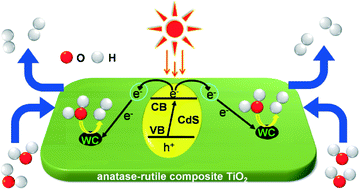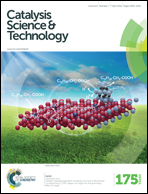CdS quantum dots and tungsten carbide supported on anatase–rutile composite TiO2 for highly efficient visible-light-driven photocatalytic H2 evolution from water†
Abstract
Developing efficient photocatalysts with noble-metal-free co-catalysts for visible-light-driven photocatalytic H2 evolution from water is appealing yet remains challenging. Herein, by supporting CdS QDs with diameters smaller than 5 nm and tungsten carbide (WC) on TiO2, a CdS/WC/TiO2 photocatalyst was fabricated for visible-light-driven photocatalytic H2 evolution from aqueous solution containing lactic acid as an electron donor. The optimal H2 evolution rate on CdS/WC/TiO2 (624.9 μmol h−1) is comparable to the H2 evolution rate on CdS/Pt/TiO2 (636.2 μmol h−1), indicating that WC is a good candidate to substitute Pt as the co-catalyst. Formation of an anatase–rutile composite TiO2 with a rutile content of 68.7% makes great contribution to the efficient H2 evolution on CdS/WC/TiO2. The rutile–anatase composite TiO2 promotes the separation of the photogenerated electron–hole pairs and thereby benefits the efficient H2 evolution reaction. The present work is expected to be helpful in designing efficient noble-metal-free photocatalysts for H2 evolution from visible-light-driven photocatalytic water splitting.


 Please wait while we load your content...
Please wait while we load your content...